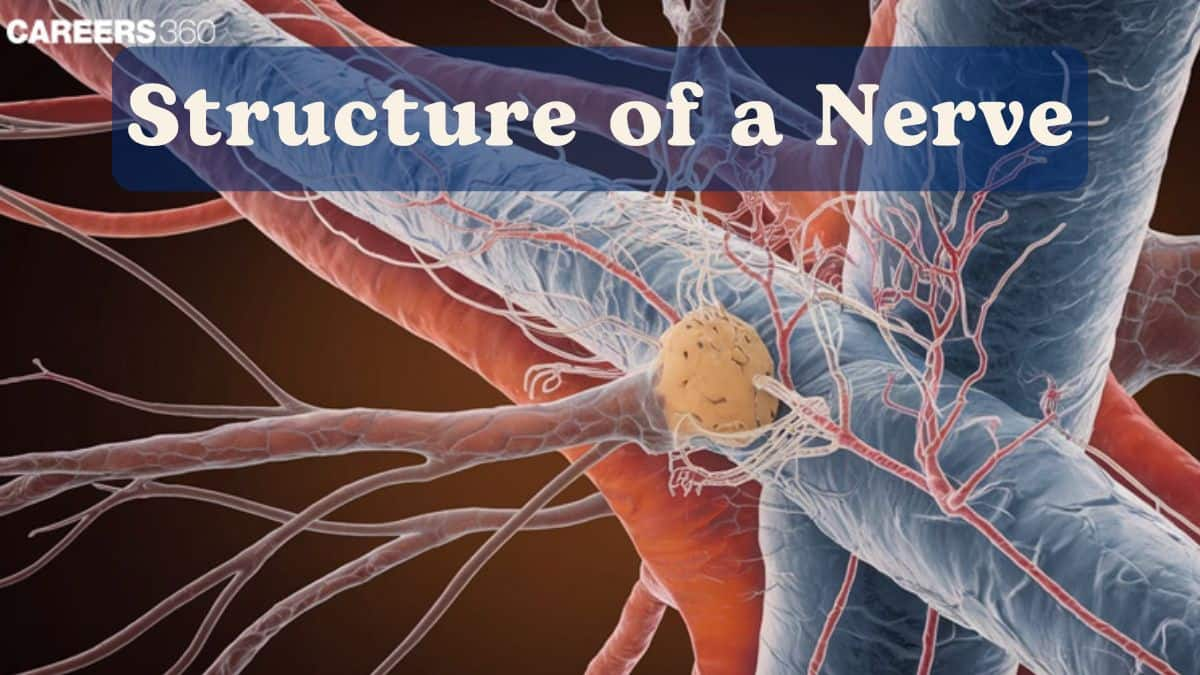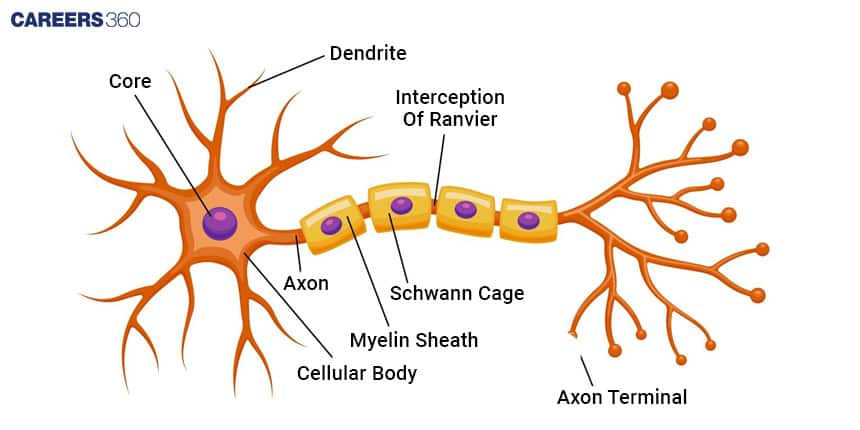Structure Of A Nerve
Nerves are specialized structures that transmit electrical signals between the brain, spinal cord, and body. They consist of bundles of axons surrounded by protective sheaths and play key roles in sensation, motor control, and coordination. Understanding nerve structure and types is crucial for NEET and Class 11 Biology.
This Story also Contains
- What is a Nerve?
- Functions of Nerves
- Types of Nerves
- Anatomy of a Nerve
- Neuron – The Basic Unit of a Nerve
- Types Of Nerve Fibers
- Types of Neurons NEET MCQs (With Answers & Explanations)
- Recommended video on "Structure of a Nerve"

What is a Nerve?
The nervous system is formed by the cells and tissues that are part of a systematized network having certain grades. It is through these specialized cells that the functions of the body are coordinated and controlled through electricity transferred between them. It further coordinates the integration of sensual information and the activities of muscles, while maintaining homeostasis.
Nerves may be considered the conduit through which organs communicate with each other. This is by information on the structure of the nervous system, functions of the nervous system and functions of nerves in impulse transmission. It also contains information on the various types of neurons and the functions of the neurons.
Functions of Nerves
Nerves are surrounded by connective tissue sheaths that may conduct electrical impulses between the central nervous system (CNS) and the peripheries of the body or the organs or muscles in the body system. These are communicated via pathways by which the brain and spinal cord convey information to various parts of the body. Therefore, they ahve become very vital in sensory perception, motor control and coordination of body functions.
At the most primitive level, the nerves are primarily used for signal transmission from sensory receptors to the CNS and from the CNS to muscles and glands. For example, information regarding stimuli such as touch and temperature of the surroundings is carried to the brain with the help of sensory nerves. Mixed nerves have both sensory and motor nerve fibres to provide complete intercommunication between different parts of the body.
Types of Nerves
Functionally, neurons are classified according to the direction in which the nerve impulse is conveyed with respect to the CNS.
Sensory Nerves
These are afferent nerves, which carry messages from the sensory receptors in the skin, eyes, ears, nose, and tongue through the spinal cord to the brain, which makes it possible for a person to see light, hear sound, and feel touch.
Motor Nerves
These are efferent nerves, which carry messages from the brain to the muscles and glands in the body to command all sorts of voluntary and.
Mixed Nerves
Such nerves contain both sensory and motor fibers. Therefore, provide two-way traffic communication between the CNS and peripheral tissues.
Anatomy of a Nerve
The anatomy of the nerve is described below-
Structure of a Nerve (axon bundles, connective tissue sheaths)
The aggregation of a large number of axons together forms a bundle. This bundle is covered by several layers of connective tissue to make a nerve. Axons are long, slender projections of the neuron that carry electrical impulses. The structure of the nerve accounts for the effective transmission of signals and also protects the axon from damage.
Supporting Structures (endoneurium, perineurium, epineurium)
The supporting structures are described below-
Endoneurium: The very thin layer of connective tissue surrounding individual nerve fibres within a nerve.
Perineurium: It is a covering of areolar connective tissue that goes into wrapping each fascicle of nerve fibres. The two main functions are extra protection and adding strength.
Epineurium: It refers to the outermost connective tissue wrapping layer around the entire nerve. Its main function is to provide some structural integrity and protection.
Neuron – The Basic Unit of a Nerve
The neuron is the simplest unit of the nerve, which is in a literal sense carrying the electrical impulse. The major components of the neuron are pointed out in the following lines.
Cell Body (Soma)
The cell body contains a nucleus surrounded by cytoplasm that includes organelles such as lysosomes, mitochondria, and a Golgi complex. They also contain free ribosomes and rough endoplasmic reticulum, termed Nissl bodies. Hence, it forms the metabolic part of the neuron.
Dendrites
These are the small branches coming out and receiving the signals from other neurons and passing them to the cell body. The plasma membranes of dendrites contain numerous receptor sites for binding chemical messengers from other cells.
Axon
The axon is the elongated projection that conducts electrical impulses away from the cell body towards other neurons or effector cells. An axon is a long, thin, cylindrical projection that often joins to the cell body at the axon hillock. It contains mitochondria, microtubules, and neurofibrils.
Myelin Sheath
It is a layer of fat, and thus it insulates the axon. The speed of transmission of impulses thus increases. The Schwann cells produce it in the peripheral nervous system and the oligodendrocytes produce it in the central nervous system.
Nodes of Ranvier
The gaps between the myelin sheaths. They allow the impulse to travel rapidly and continuously through a process called saltatory conduction.
Axon Terminals
Axon terminals are the ends of the axon. Neurotransmitters spill out into other neurons or muscle cells and communicate with them.

Types Of Nerve Fibers
The types of nerve fibers are classified based on diameter and speed of conduction.
Fibres (Alpha, Beta, Gamma, Delta): These are the myelinated nerve fibres of varying diameters and thus have varying conduction velocities. They are ascribed to conduct motor commands and sensory information at a fast pace.
B Fibers: These are the myelinated fibres of intermediate diameters and conduction velocities. They are responsible for autonomous functions.
C Fibers: Unmyelinated ones of small diameters with slow conduction velocities that transmit painful sensations and temperature.
Types of Neurons NEET MCQs (With Answers & Explanations)
Important topics that are frequently asked in NEET exam are:
Structure of a nerve with diagram
Types of nerves (sensory, motor, mixed)
Role of Nodes of Ranvier
Types of nerve fibers and functions
Practice Questions for NEET
Q1. Which of the following is a sensory nerve?
Olfactory
Optic
Both a and b
None of these
Correct answer: 3) Both a and b
Explanation:
The structure of a nerve consists of a bundle of individual nerve fibres, which together form a structure called fasciculi. Each nerve is surrounded by epineurium, a layer of connective tissue, while each fasciculus is covered by perineurium, another layer of connective tissue. Within the nerve, individual nerve fibres are surrounded by endoneurium. Nerves transmit information in the form of electrochemical impulses (or nerve impulses), which are carried by neurons. These impulses travel extremely fast, with myelinated neurons conducting at speeds up to 120 m/s. Nerve impulses are transmitted from one neuron to another by crossing a synapse, where the signal is converted from electrical to chemical and back to electrical. Sensory nerves, such as the olfactory and optic nerves, contain sensory fibres (afferent fibres) that carry sensory information from the body to the brain.
Hence the correct answer is option 3) Both a and b
Q2. Muscle fibre : endomysium :: Nerve fiber : ____
Endoneuron
Endoneurium
Endoplasm
None of these
Correct answer: 2) Endoneurium
Explanation:
Inside the nerve, each nerve fibre is surrounded by endoneurium. Inside a nerve, each nerve fibre is surrounded by a connective tissue layer called the endoneurium. The endoneurium consists of a thin layer of collagen fibres and fibroblasts that provide structural support and help maintain the environment around the nerve fibres. It also plays a role in the repair and regeneration of nerve fibres after injury. Multiple nerve fibres, along with their endoneurium, are grouped into fascicles, which are further surrounded by a protective sheath called the perineurium.
Hence, the correct answer is option 2) Endoneurium.
Q3. All spinal nerves are
Mixed
Motor
Sensory
None of these
Correct answer: 1) Mixed
Explanation:
Since all spinal nerves are mixed, both motor and sensory fibers are present.
Muscles and glands get messages from the central nervous system (CNS) through motor fibers.
The body sends sensory data to the central nervous system (CNS) via sensory fibers.
Spinal nerves are categorized as mixed because they perform both roles, enabling the transfer of signals to and from the body.
Hence, the correct answer is option 1) Mixed.
Also Read:
Recommended video on "Structure of a Nerve"
Frequently Asked Questions (FAQs)
The myelination of axons with the myelin sheath increases its velocity in conducting an impulse of a nerve through saltatory conduction.
Nerve fibres are classified as A, B, and C fibres that vary in terms of diameter, amount of myelination, and speed of conduction as well as functions.
Yes, nerves of the PNS are regenerative with the assistance of the Schwann cells in offering locations with which the fibres can grow. There is very little, if any, capacity in the CNS for the regrowth to take place in the regeneration process.
Probably the most known nerve disorders include neuropathy, multiple sclerosis, and ALS or Lou Gehrig's disease. Each of these is very different etiologies with different symptoms associated with it.